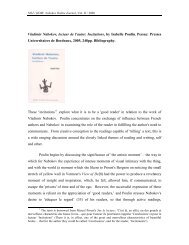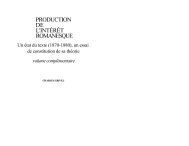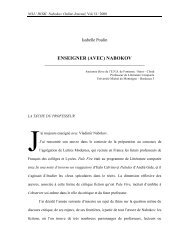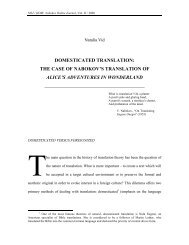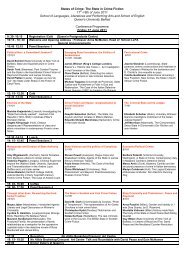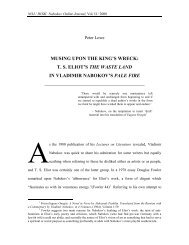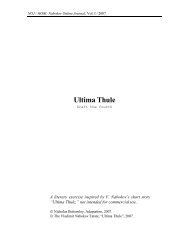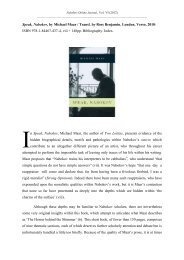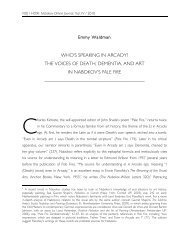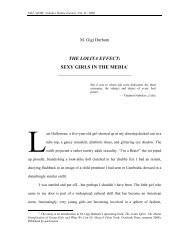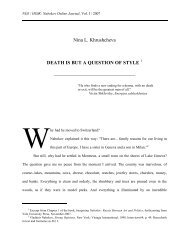TRANSITIONAL NABOKOV - Electronic Text Centre
TRANSITIONAL NABOKOV - Electronic Text Centre
TRANSITIONAL NABOKOV - Electronic Text Centre
Create successful ePaper yourself
Turn your PDF publications into a flip-book with our unique Google optimized e-Paper software.
NOJ / НОЖ: Nabokov Online Journal, Vol. II / 2008<br />
<strong>TRANSITIONAL</strong> <strong>NABOKOV</strong><br />
________________________________________________<br />
Conference Overview<br />
6-7 July 2007<br />
A two-day international conference hosted by the Rothermere American Institute, Oxford University<br />
The Round Table participants: Zoran Kuzmanovich, Alexander Dolinin, Brian Boyd,<br />
Ron Bush (Chair), Maurice Couturier, Susan Elizabeth Sweeney, Neil Cornwell. Photo Y. Leving.<br />
T<br />
ransitional Nabokov was conceived as a way of bringing various strands of<br />
Nabokov scholarship into dialogue. Nabokov studies is an increasingly<br />
diversifying field, and the conference brought together scholars from<br />
numerous critical locations in order to present their latest research. Delegates came from
W. Norman, D. White. “Conference: Transitional Nabokov”<br />
as far away as New Zealand, Japan and Brazil to attend the conference, which featured 26<br />
speakers from a range of nations. Plenary lectures were delivered by two scholars who<br />
have, over a number of years, produced some of the most engaging and exciting work on<br />
Nabokov, Michael Wood and Alexander Dolinin. We were also lucky enough to have<br />
some other well-known figures in the field, such as Brian Boyd, Zoran Kuzmanovich,<br />
Neil Cornwell, and Maurice Couturier. At the other end of the spectrum, we had papers<br />
from a number of Nabokovians at the beginning of their careers. Also present was<br />
Tatiana Ponomareva, the director of Nabokov museum in St. Petersburg, who introduced<br />
a fascinating exhibition of visual art inspired by the writer’s work. The conference<br />
successfully created the opportunity for an exciting conversation across the discipline of<br />
Nabokov studies.<br />
The theme of transition was chosen not only as a reflection on the discipline<br />
itself, but also as a broad paradigm for approaching Nabokov texts. The conference<br />
suggested that there is much to be gained from reading Nabokov’s literary practice as<br />
existing and operating between categories of various kinds. For a writer who<br />
experimented with several languages and forms during his career, this seems particularly<br />
appropriate, and several papers were delivered on issues such as translation, Nabokov’s<br />
language-shift and the interrelationship of drama and fiction. Attention was also paid to<br />
the various ways Nabokov’s literary strategies and aesthetics altered over time, across the<br />
trajectory of his career. There was much opportunity for discussing numerous conceptual<br />
transitions occurring within Nabokov’s works, concentrating on the various mediating<br />
functions of language, enabling shifts from text into image, music, and cognitive forms.<br />
Another productive area of enquiry was the interrelationship of Nabokov with other
NOJ / НОЖ: Nabokov Online Journal, Vol. II / 2008<br />
writers, thinkers and artists. The exploration of Nabokov’s place within particular cultural<br />
configurations both during and since his death has become a rewarding area of study, and<br />
the author was read alongside figures as diverse as Kurt Vonnegut, Theodor Adorno,<br />
Sergei Rachmaninoff, and Michael Chabon. The conference also provided a chance for<br />
retrospective thoughts on the history of Nabokov studies itself, and the ways in which his<br />
texts have responded to particular critical approaches.<br />
Special mention should be made of the work devoted to the relationship between<br />
Nabokov’s art and his scientific activities. This is one of the most highly contested issues<br />
in the discipline, and provided the material for a number of papers. In particular, there<br />
was debate over the intellectual validity of Nabokov’s scientific views, and the<br />
compatibility of his scientific and literary practice. In view of the research on Nabokov’s<br />
science that we hope to see published over the coming years, this seems likely to be<br />
territory of persistent interest in the future. The other most vigorously contended question<br />
was over Nabokov’s attitude to his Russian works after he began to write fiction in<br />
English. While scholars such as Alexander Dolinin have previously suggested that<br />
Nabokov strategically created an image of Sirin and his Russian works after his move to<br />
America, Brian Boyd here argued that Nabokov’s later years represented an integrated<br />
and continuous development of his artistic project.<br />
Given the theme of the conference, it was perhaps inevitable that the majority of<br />
the discussion focused on texts written during the middle of Nabokov’s career, including<br />
several that have received comparatively light critical attention. The most commonly<br />
discussed texts were Priglashenie na kazn’, The Real Life of Sebastian Knight, Bend<br />
Sinister, Pnin and Lolita. It became clear during the course of the conference that the
W. Norman, D. White. “Conference: Transitional Nabokov”<br />
unsettled period of Nabokov’s geographical and linguistic transitions in the late 1930s<br />
and 1940s is tremendously significant for Nabokov’s later career, and provides the source<br />
of several major themes within his work. It is also proving a very rich and productive<br />
field of enquiry for Nabokov studies.<br />
The conference concluded with a round-table discussion chaired by Ronald Bush,<br />
which included Brian Boyd, Alexander Dolinin, Maurice Couturier, Neil Cornwell, Susan<br />
Elizabeth Sweeney, and Zoran Kuzmanovich. The dominant topic here was the future of<br />
Nabokov scholarship. The ongoing process of textual annotation was suggested as a<br />
likely object of future work, while it was pointed out that Nabokov’s working habits and<br />
relatively clean drafts made manuscript study less rewarding than in comparable<br />
disciplines. Ronald Bush made interesting comparisons between Nabokov and Joyce<br />
studies, pointing out that the fragmentation which currently marks the latter is perhaps an<br />
eventuality to be consciously evaded by this, relatively young, field of study. The<br />
necessity of continued and constructive conversation between all strands of Nabokov<br />
scholarship is clear.<br />
Transitional Nabokov was made possible through the generous support of The<br />
Rothermere American Institute, along with important contributions from Maison<br />
Francaise and the Oxford University faculties of English and of Modern Languages.<br />
Thank you once again to all our speakers and delegates for helping to create such a<br />
stimulating and constructive event.<br />
Will Norman,<br />
Duncan White<br />
Oxford University
NOJ / НОЖ: Nabokov Online Journal, Vol. II / 2008<br />
OVERVIEW OF PAPERS<br />
________________________________________________<br />
Presenter Duncan White (Oxford), Chair of the panel Prof. Dale Peterson (Amherst). Photo Y. Leving.<br />
Michael Wood (Princeton)<br />
Nabokov: The Kindness of Cruelty<br />
Wood’s paper deals with transitions in views of Nabokov's aesthetics, and the<br />
apparent contradiction between his insistence (in the afterword to Lolita) on kindness and<br />
his insistence (almost everywhere else) on his necessary coldness and cruelty. Wood<br />
believes there is a deep consistency in this, but it does need digging out, and it has to do<br />
not only with Nabokov's idea of art but also that (pretty strange) claim that there are<br />
'states of being where art... is the norm'. Since when, Wood asks, was he so keen on<br />
norms?
Alexander Dolinin (Wisconsin-Madison)<br />
Reading Lolita with a Russian Accent<br />
W. Norman, D. White. “Conference: Transitional Nabokov”<br />
In the English novels up to Pale Fire Nabokov concealed Russian allusions and<br />
references that were used as a private code undecipherable by the American or British<br />
reader. The Russian substratum is especially important in the first-person narratives as it<br />
lies beyond the grasp of the non-Russian narrator and reveals the authorial presence. At<br />
the centre of Dolinin’s discussion was such a substratum in Lolita that goes from<br />
bilingual obscene jokes to hidden Pushkin subtexts. Dolinin’s paper reread the novel<br />
according to a list provided by Nabokov in “On a Book Entitled Lolita” that includes<br />
references to what the writer calls “the nerves of the novel,” “the secret points, the<br />
subliminal co-ordinates by means of which the book is plotted.” Dolinin argued that most<br />
of the scenes have an important Russian component overlooked in Lolita criticism.<br />
Zoran Kuzmanovich (Davidson)<br />
Report[:] “No Ghosts Walk” or “The Already Told is Bunched Up Again”<br />
This paper meditated on the differences between a reading strategy that decides to<br />
do without the theological and puzzle-solving meaning and a strategy that sets out to<br />
recover, limit, and defend such a meaning through the invocation of Nabokov's always<br />
overdetermined ghostly presence. Kuzmanovich argued that the second strategy leads to a<br />
double-bind. Because Nabokov was already a self-annotator, dispenser of annotations,<br />
inventor of serial selves, notoriously generous provider of red herrings and cartographer<br />
of nerve points of which most readerly anatomies are innocent, reading Nabokov's<br />
fictions so as to unconceal inscribed otherworldly presences, anagram-loving phantoms,<br />
or the textualized landscape of St. Petersburg makes Nabokov live outside his writing<br />
space as a competitive phantom of one's reading while at the same time forcing one to<br />
confess one's own alienating distance from the Nabokov text, distance to which one's<br />
commentary can only serve as a monumental testament. The second consequence has to
NOJ / НОЖ: Nabokov Online Journal, Vol. II / 2008<br />
do with the tone of one's annotations or comments produced out of precisely such a<br />
double bind being read as acts of aggression towards both Nabokov and the critic's<br />
presumed audience.<br />
Brian Boyd (Auckland)<br />
Nabokov as a Formerly Russian Writer: Transitions between Traditions<br />
Nabokov’s Transition from Russian to English: Repudiation or Evolution?<br />
Boyd’s paper took issue with an earlier Dolinin article’s claim that Nabokov’s<br />
switch to English prompted a disavowal of his former engagement with Russian<br />
literature, a diminution of his own Russian achievement and a “mythmaking” self-<br />
portrayal as “a born cosmopolitan” who “had always stood apart from literary battles and<br />
discussions.” Boyd argued that this itself was a myth. Nabokov’s severity not only on<br />
literature he deemed overrated and meretricious but on some of his own past work and on<br />
what he thought the masterpieces of world literature can be explained not in terms of a<br />
mythmaking repudiation of his Russianness but in terms of an aspect of his thought that<br />
has not been sufficiently appreciated: his strongly melioristic sense of cultural<br />
development that he imbibed in part from his father and from late nineteenth- and early<br />
twentieth-century cultural thought.<br />
Neil Cornwell (Bristol)<br />
Sirin to Nabokov and Beyond: the Transitional <strong>Text</strong>s<br />
This paper examined the fiction of the key, transitional pre-American period (of<br />
the late 1930s) when Nabokov was working in three languages, taking in ‘Colette’<br />
(1948), subsequently entitled ‘First Love’. There was a backward glance at ‘First Love’<br />
by Turgenev, and a sideways glance at Beckett’s somewhat contrasting ‘Premier amour’<br />
(written 1946; published only, in French and then in English, as – once again – ‘First<br />
Love’, in the 1970s). Cornwell also examined the legacy of Nabokov on writers such as<br />
Orhan Pamuk.
Maurice Couturier (Nice)<br />
The French Nabokov<br />
W. Norman, D. White. “Conference: Transitional Nabokov”<br />
Nabokov once said that he "could have been a French writer." He spent a great<br />
deal of time in France during his childhood and his Berlin years, and he settled in Paris at<br />
the end of the thirties. His written and spoken French was of a high standard, as the texts<br />
he wrote in that language testify. French literature is omnipresent in his works, and he<br />
lectured extensively on writers like Proust and Flaubert. Perhaps it was hardly a<br />
coincidence that Lolita, whose narrator is a French speaker, was published in Paris. Yet,<br />
his particular kind of imagination might have been a little cramped if he had chosen<br />
French rather than English after 1938-9.<br />
Stephen Blackwell (Tennessee)<br />
“Fugitive Sense” in Nabokov<br />
Throughout the 1930s, Nabokov’s interest in his art’s ability to capture fluidity<br />
and ambiguity grew increasingly acute, in parallel with his deepening expertise in<br />
lepidoptery and evolutionary theory. His works display a deceptive surface narrative that<br />
turns out to be in small or large degree a camouflage for a more significant covert<br />
narrative encoded within it. The (at least) dual, “fugitive” meaning of the same set of<br />
words, whose significance emerges during an extended experience through multiple<br />
readings, became the core feature of Nabokov’s artistry in his mature phase. While<br />
metamorphosis has understandably been the preferred term for such shifts between levels<br />
of meaning, another term serves the purpose and specifics of Nabokov’s art even better:<br />
evolution. As an on-going process, evolution expresses the ever-changing realizations of<br />
Nabokov’s works in the world of good readers.<br />
Having established Nabokov’s developing views on species development and<br />
classification during the late 1930s and 1940s, this paper examines how this scientific<br />
epistemology brings about in Nabokov a profound modesty that finds subtle expression in<br />
diverse spheres of his activity—lepidoptery, in chess problems, and in art. In this medley<br />
of perspectives upon human efforts to perceive, know, and express truths about the world,
NOJ / НОЖ: Nabokov Online Journal, Vol. II / 2008<br />
Nabokov demonstrates his concern for the uneasy slippage between the desire for<br />
knowledge and the desire for power, control, and certainty.<br />
Leland de la Durantaye (Harvard)<br />
Transitions between Science and Art, or that other VN<br />
In this paper De la Durantaye discussed the deceptive transitions between<br />
Nabokov’s views on science and art, between creativity in nature and creativity in art.<br />
Nabokov famously promised a “furious refutation” of Darwinian natural selection and<br />
dismissed what he saw as the latter’s crudely utilitarian view of nature as evidenced in his<br />
theories concerning animal mimicry. For Nabokov, “that other V.N.” (visible nature)<br />
created along different lines and with different aims. De la Durantaye explored<br />
Nabokov’s dismissal of Darwinian natural selection in light of the transitions made<br />
between his scientific and artistic views, with particular attention paid to conceptions of<br />
“crude utility” and refined creation, and to the thematic patterning found in his literary<br />
works. The paper argued that not only did Nabokov’s scientific pursuits inform his<br />
literary ones, but that his aesthetic beliefs shaped his scientific ones, and vice versa, in<br />
more fundamental fashion, and how they govern the transitions in Nabokov’s work from<br />
non-fiction to fiction, life to literature.<br />
Will Norman (Oxford)<br />
Reading Nabokov with Adorno<br />
This paper takes issue with the idea that Nabokov’s texts were written, and should<br />
be read, in isolation from history. Examining Bend Sinister alongside Theodor Adorno’s<br />
work on “the culture industry,” developed in American during the same period, I argue<br />
that Nabokov’s engagement with paradigms of high modernist and mass culture in his<br />
novel represent a response to history. Both Adorno and Nabokov fled totalitarian Europe<br />
for America in search of intellectual and artistic freedom, but both were unsettled by the<br />
congruences between American popular culture and the political conditions they had left<br />
behind. While Nabokov remained dedicated to the notion that his experimental style
W. Norman, D. White. “Conference: Transitional Nabokov”<br />
could ultimately transcend the dual threat of tyranny and mass culture, with problematic<br />
ethical implications, Adorno’s negative dialectics provides us with the opportunity to<br />
rehistoricise Nabokov, and to evaluate the costs of his aesthetic ideals.<br />
Christine Raguet (Sorbonne)<br />
Beyond Creativity – Translation as Transitional Process: Ada in French<br />
When Nabokov fully implicated himself in the translation of Ada, he probably<br />
meant to assign a new value to the novel, to open up a well sealed whole to different<br />
readers. Still, how could the hybrid language and culture conveyed in the original adapt<br />
to a new medium without warping such significant elements as the sound and sense<br />
relationship, which establishes itself in the novel? The contrastive study of the original<br />
and its French translation may help understand how ethics and poetics were at stake and<br />
entailed Nabokov’s own engagement in this assessing process—a creation twice<br />
removed.<br />
Dale Peterson (Amherst)<br />
Knight’s Move: Nabokov, Shklovsky and the afterlife of Sirin<br />
Peterson’s elegantly delivered paper focused on The Real Life of Sebastian<br />
Knight, in which Nabokov faced the considerable challenge of transferring a distinctive<br />
literary identity by means of partial hints transcribed in a foreign tongue. Everything in<br />
Nabokov’s debut English novel is about transference, translation, and sudden transition<br />
from one state of existence to another. The birth of Sirin coincided with the appearance in<br />
Berlin of Viktor Skhlovsky’s artistic treatise for Russians abroad, Knight’s Move (1923).<br />
Sebastian’s texts move with cunning indirection like Shklovsky’s metaphor for artistic<br />
composition, the chess knight who “moves laterally (xoдит в бок) because the straight<br />
road is forbidden.” Read as a metatextual reflection of Nabokov’s labile position between<br />
languages and cultures in 1940, the novel performs the trick of sidestepping the death of<br />
Sirin by transferring into English Nabokov’s characteristic narrative signature – his
NOJ / НОЖ: Nabokov Online Journal, Vol. II / 2008<br />
evocation of two non-coinciding worlds that appear to intersect in the multidimensional<br />
realm of imaginative artifice.<br />
Challenges<br />
Elena Murenina (East Carolina)<br />
Defining Nabokov-Sirin: Russian Émigré Criticism, Predictions and<br />
Murenina’s paper engaged with the early reception of Nabokov’s work in the<br />
emigration, when he was charged primarily with “un-Russianness” by the majority of the<br />
Parisian critics. Analyzing the transition of Nabokov’s reception in Prague, Berlin, Paris,<br />
and Sophia during the 1920-30s, she focused on the ‘scholarly’ branch of Russian émigré<br />
criticism represented by Alfred Bem, Vladimir Weidle, and Pyotr Bitsilli, whose critical<br />
legacies remained largely neglected by American scholars and are still not available in<br />
English. Murenina sought to dispel the common myth of Nabokov’s ‘non-recognition’ as<br />
a Russian writer among his émigré contemporaries.<br />
Thomas Karshan (Oxford)<br />
Nabokov’s Transition from Game towards Free Play, 1934-1947<br />
This paper argues that in the years between 1934 and 1947 Nabokov’s art<br />
underwent a subtle but profound transformation which coincides with but is distinct from<br />
the passage from Russian through French into English. Nabokov worked to erase any<br />
vestiges of the didactic and determinate author in his writing, as can be seen most clearly<br />
by examining how he transformed Invitation to a Beheading into Bend Sinister. This<br />
paper describes this transformation and argues that it is illustrated by a shift in Nabokov’s<br />
images of games, from games with rules to images of anarchic free play – often<br />
childhood play.
1940s<br />
Siggy Frank (Nottingham)<br />
W. Norman, D. White. “Conference: Transitional Nabokov”<br />
Stages and Transitions: Theatricality in Nabokov’s Fiction of the 1930s and<br />
During the 1930s and 1940s Nabokov experienced changes on a geographical,<br />
linguistic and artistic level. It is during this period that theatrical themes, imagery and<br />
models clearly emerge in Nabokov’s work. Frank’s paper examined the function of<br />
theatre as a place of transition in Nabokov’s work. It looks at how the essential features<br />
of theatrical performance, its temporal and physical impermanence, as well as its twofold<br />
perception of reality, become in Nabokov’s dramas and fiction a metaphor for border-<br />
crossing and the exile condition. It also argues that the theme of theatricality is central to<br />
an understanding of the transformation of the writer himself: the transition from Sirin to<br />
VN.<br />
Susan Elizabeth Sweeney (Holy Cross)<br />
Thinking About Impossible Things in Nabokov<br />
Sweeney’s paper used conceptual blending theory to propose a model for the way<br />
in which Nabokov’s fictions transgress the borders between imaginary worlds. Such<br />
transitions ultimately occur not within the text, but in a reader’s consciousness.<br />
Fauconnier and Turner’s theory of “conceptual blending”—in which the mind conjures<br />
up new scenarios by combining different frames of possibility—provides a good analogy<br />
for the effect of Nabokov’s fiction. It also offers a method for analyzing how Nabokov<br />
achieves this effect: through specific sleights of mind that are evoked in his narration and<br />
realized in the consciousness of his readers.<br />
Lara Delage-Toriel (Strasbourg)<br />
Bodies in Translation: Deriving Meaning from Motion in Nabokov’s Works<br />
Much thought has been devoted to the intellectual, moral, spiritual, metaphysical<br />
and aesthetic dimensions of Nabokov’s fictional world, but much less has been said about
NOJ / НОЖ: Nabokov Online Journal, Vol. II / 2008<br />
its actual physicality, argued Delage-Toriel. This paper explored the significance in the<br />
relationship between body and language in terms of boundaries and limits, both physical<br />
and cultural. It approached Nabokov’s work from a fresh, kinetic angle, bringing into<br />
perspective the specific impact of physical motion within the dynamic space of his<br />
fictional world and language.<br />
Emily Collins (Bristol)<br />
A Luminous Web: Nabokov’s Animate Objects<br />
Collins situates Nabokov’s objects within the concept of the fetish, an object that<br />
is revered in and of itself. Both Marx (commodity) and Freud (sexual) applied this<br />
concept and in Lolita, Humbert both mocks and mimics manifestations of both kinds of<br />
fetishism. The portal is another object to be found in Nabokov’s fiction, something that<br />
opens up networks in space, time and fiction, and whereas the fetish object has life in<br />
itself, the portal is energised by its liminal position (Luzhin’s chess pieces). Both objects<br />
are problematic and Collins concludes that in fact the text becomes the supreme magical<br />
object.<br />
Duncan White (Oxford)<br />
Dyeing Lolita: Nymphet in the Paratext<br />
This paper investigated the way Lolita, the character, has been received and the<br />
role that paratextual material has played in that reception. Nabokov was, more than any<br />
writer before him, invested in how his books were designed and would even help design<br />
the covers of his novels. Paratexts play a crucial role in defining a reader’s expectations.<br />
Nabokov initially insisted that “no girls” should be placed on the covers of Lolita and his<br />
publishers in the US and the United Kingdom followed this edict. However, with the<br />
Kubrick film and the paperback editions, Nabokov began to lose control of the Lolita<br />
phenomenon. As we are confronted by ever more graphically sexualised cover art for<br />
Lolita, White argues that it was an essential component of the novel that Dolores can only
W. Norman, D. White. “Conference: Transitional Nabokov”<br />
be filtered through Humbert’s consciousness and that her representation in the cover art<br />
undermines the novel’s structure.<br />
Yuri Leving (Dalhousie)<br />
<strong>Text</strong> to Music: Nabokov and Rachmaninoff<br />
Despite Nabokov’s claims to being tone-deaf, in the early 1940s he collaborated<br />
on two musical projects with composer Sergei Rachmaninoff. Using correspondence<br />
from the Rachmaninoff archives, Leving elucidates this work that, until now, has been<br />
overlooked. Nabokov was commissioned to prepare the English text of “The Bells”<br />
(Symphony No 3, op. 44) for performances in the United States, trying to make<br />
Rachmaninoff’s music fit the words of the Edgar Allan Poe poem of the same name<br />
(Rachmaninoff’s version had been based on an earlier translation by Balmont). Nabokov<br />
also specially adapted the monologue of the Covetous Knight from Pushkin’s long poem,<br />
but the project remained unfinished due to Rachmaninoff’s deteriorating health.<br />
Russell Kilbourn (Wilfrid Laurier)<br />
The gift of being remembered: Speak, Memory and W.G. Sebald’s Austerlitz<br />
Kilbourn has argued that Nabokov can be described as the ‘tutelary deity’ of<br />
Sebald’s second pseudo-novel, The Emigrants. In subsequent works like The Rings of<br />
Saturn and Austerlitz, Sebald extends and complicates his intertextual relation to<br />
Nabokov. In this paper Kilbourn elaborates on Sebald’s deliberate incorporation of<br />
specific passages and images from Speak, Memory in the narrative of Austerlitz, focusing<br />
primarily on the protagonist’s attempts to recuperate mnemic representations of the<br />
mother he cannot remember knowing. Kilbourn has used his research in the Sebald<br />
Archive in Marbach, Germany, where, in Sebald’s own copy of Nabokov’s<br />
autobiography one can see marginal notations and other indications of the manner in<br />
which he adapted and ‘translated’ certain scenes or elements into his own version of a<br />
fictional biography.
NOJ / НОЖ: Nabokov Online Journal, Vol. II / 2008<br />
Barbara Wyllie (University College London)<br />
Terra, Tralalitions and Tralfamadore: Parallel Universes in the Fiction of<br />
Nabokov and Kurt Vonnegut, Jr.<br />
In this paper, Wyllie acknowledged that while the juxtaposition of Nabokov and<br />
Vonnegut might seem surprising, these two apparently different writers do share certain<br />
interesting affinities. In 1969, Vonnegut published Slaughterhouse-Five and Nabokov<br />
published Ada and both works are concerned with time, mortality and parallel worlds.<br />
Wyllie goes on to draw comparison with the experiences of Billy Pilgrim and Hugh<br />
Person of Transparent Things, especially in their relationship to<br />
supernatural/extraterrestrial solutions to mortality.<br />
Rachel Trousdale (Agnes Scott)<br />
Nabokov: the Model Transnational<br />
Trousdale’s paper highlighted the fact that Nabokov is cited as an influence by a<br />
broad spectrum of contemporary writers, especially those who write about experiences of<br />
exile or in a multicultural milieu. Why, asks Trousdale, does this vehemently apolitical<br />
writer appeal to this often highly political novelists? Using Michael Chabon’s 2007 novel<br />
The Yiddish Policemen’s Union, with its structural basis in a Nabokvian chess problem,<br />
as her example, Trousdale argues that contemporary writer use Nabokov as a model for<br />
community building.



